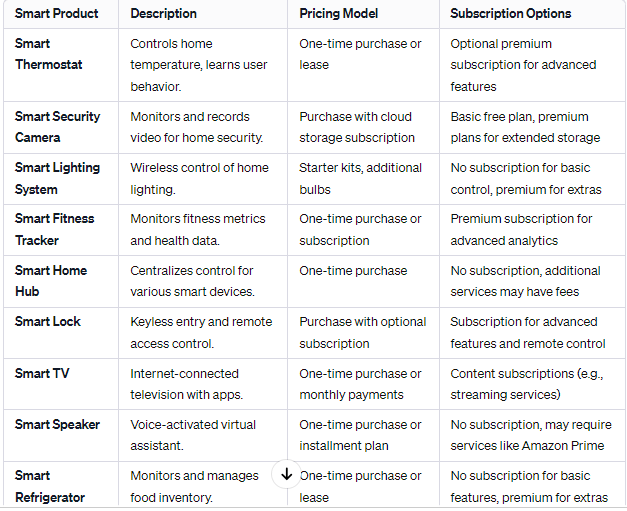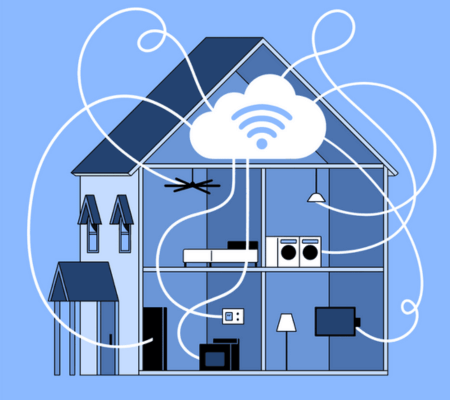Welcome to the future, where our homes are getting smarter and more connected. Smart home technology has taken the world by storm, revolutionizing the way we live and interact with our living spaces. From voice-controlled assistants to automated lighting systems, smart homes have become a hot topic of conversation.

But with so many available options, choosing the right smart home platform that suits your needs can be overwhelming. That’s why we’re here to guide you through this maze of possibilities and help you find the best fit for your home.
This blog post’ll explore some of the most popular smart home platforms today: Amazon Alexa, Google Assistant, and Apple HomeKit. We’ll dive into their features and compatibility, user-friendliness and accessibility, integration with other devices, pricing models, and security concerns – everything you need to make an informed decision.
So if you’re ready to unlock a whole new level of convenience and control with smart home technology, let’s get started!
Table of Contents
ToggleThe Rise of Smart Homes
Smart homes have become a common sight, as technology continues to infiltrate every aspect of our lives. From thermostats that adjust based on our preferences to door locks that can be controlled remotely, smart home devices are transforming how we interact with our living spaces.
One of the key drivers behind the rise of smart homes is the increasing need for convenience and efficiency in our daily lives. With busy schedules and limited time, controlling various aspects of our home with just a few taps or voice commands has become incredibly appealing.
Not only do smart homes provide us with convenience, but they also offer enhanced security features. With advanced surveillance systems and motion sensors, homeowners can keep an eye on their property even when they’re away. This added layer of protection brings peace of mind and makes smart homes an attractive option for those concerned about safety.
In addition to convenience and security, smart home technology also contributes to energy efficiency. Devices such as smart thermostats help optimize temperature settings based on occupancy patterns, saving both energy and money in the long run. This eco-friendly aspect appeals not only to environmentally conscious individuals but also those looking for cost-saving measures.
As more companies enter the market with innovative solutions, there’s no doubt that the rise of smart homes will continue unabated. The integration of artificial intelligence (AI) into these devices further expands their capabilities by learning user preferences over time and adapting accordingly.
It’s clear that smart homes are here to stay. They offer unparalleled convenience, improved security features, and energy-efficient solutions – all aimed at making our lives easier and more comfortable. So if you haven’t jumped on the bandwagon yet, now might be the perfect time to embrace this exciting new era in home automation!
What is a Smart Home Platform?
In the world of smart homes, a platform serves as the backbone that brings together various devices and allows them to communicate and work seamlessly. Think of it as a central hub that controls all your smart devices.
A smart home platform acts as a control center for your connected devices, enabling you to manage everything from lights and thermostats to security systems and entertainment devices. It provides a unified interface through which you can monitor and control different aspects of your home with just a few taps on your smartphone or voice commands.
These platforms come in different forms, such as apps or virtual assistants like Amazon Alexa, Google Assistant, or Apple HomeKit. Each platform has its unique set of features and compatibility with different brands and types of smart devices.
Whether you prefer the convenience of voice-controlled assistants like Alexa or Google Assistant, or the ecosystem integration offered by Apple HomeKit, there is an option out there that suits your needs. The key is finding the right balance between compatibility with existing devices and personal preferences in terms of user-friendliness.
Choosing the best smart home platform depends on factors such as device compatibility, ease of use, integration capabilities, pricing models (including potential subscription fees), security concerns, and personal preferences for brand loyalty. When selecting a platform for your smart home setup, make sure to consider these factors carefully before making an informed decision about which one works best for you.
Popular Smart Home Platforms: Amazon Alexa, Google Assistant, and Apple HomeKit
Smart home platforms have become the backbone of modern smart homes, bringing convenience and control to our fingertips. Among the popular smart home platforms available today are Amazon Alexa, Google Assistant, and Apple HomeKit. Each platform offers its own unique features and compatibility with various devices.
Amazon Alexa is known for its vast library of skills and seamless integration with a wide range of devices, including smart speakers, thermostats, door locks, and more. Its voice recognition capabilities make it easy to interact with your smart home using simple voice commands.
On the other hand, Google Assistant combines powerful artificial intelligence with an intuitive user interface. It seamlessly connects with Google’s ecosystem of products such as Nest devices and Chromecast for a cohesive smart home experience.
Apple HomeKit offers a secure environment for controlling your smart home devices using Siri voice commands or through the Home app on iOS devices. With end-to-end encryption and strict privacy measures in place, Apple prioritizes security without compromising on functionality.
When choosing a smart home platform, consider factors like device compatibility, ease of use, and integration options with other devices you already own or plan to buy in the future. Take into account your personal preferences regarding voice assistants as well.
In conclusion (not concluding): While each platform has its strengths and weaknesses, there is no one-size-fits-all solution when it comes to choosing the best smart home platform. It ultimately depends on your specific requirements and priorities as every individual’s needs differ when it comes to their ideal smart home setup!
Features and Compatibility
Smart home platforms offer a wide range of features and compatibility options, allowing users to customize their connected homes according to their specific needs and preferences. One of the key features that sets these platforms apart is voice control. With Amazon Alexa, Google Assistant, and Apple HomeKit, you can speak commands to control your smart devices without having to lift a finger.
In terms of compatibility, all three platforms support a variety of popular smart devices such as thermostats, lights, door locks, cameras, and more. However, it’s important to note that some devices may only be compatible with certain platforms. For example, if you have Google Nest products like the Nest Learning Thermostat or Nest Cam Indoor/Outdoor security cameras, they would integrate seamlessly with Google Assistant.
Another important aspect of compatibility is cross-platform integration. While each platform has its ecosystem of compatible devices and apps, many manufacturers are now making their products compatible with multiple platforms for enhanced flexibility. This means that even if you choose one platform initially but decide to switch later on down the line,
you won’t necessarily have to replace all your existing smart devices.
Furthermore, user-friendliness is crucial in determining which smart home platform is best suited for you.
For instance, Alexa’s interface is intuitive, and navigating through its app or voice commands feels seamless.
Google Assistant equally offers an accessible user experience.
Apple HomeKit, on the other hand, is known for its simplicity and integrates smoothly with other Apple devices.
To make an informed decision about which smart home platform suits your needs, it’s recommended to consider factors such as pricing models and subscriptions.
Some platfоrms offer free access to basic features while charging for advanced capabilities.
Others require а monthly оr yearly subscription fee.
Security concerns should also be taken into account when choosing a platform.
Research how each company handles data privacy and encryption protocols before committing to any particular platform.
User-Friendliness and Accessibility
Regarding smart home platforms, user-friendliness and accessibility are crucial in enhancing the overall experience. After all, what good is a smart home if you can’t easily control it?
Amazon Alexa has gained popularity due to its intuitive voice commands. Setting up devices with Alexa is seamless, allowing users to control their smart home with just a few words. The wide range of compatible devices also adds to its appeal.
Google Assistant also offers excellent user-friendliness and accessibility. With its simple interface and ability to integrate seamlessly with other Google services, controlling your smart home becomes effortless. Plus, the Google Home app provides an easy way to manage all your connected devices in one place.
Apple HomeKit may have a more limited range of compatible devices than Amazon Alexa or Google Assistant, but it excels in user-friendliness for Apple users. The Siri voice assistant makes controlling your smart home as easy as asking your iPhone or iPad.
The level of user-friendliness and accessibility will depend on individual preferences and needs. Some may prioritize voice control convenience offered by assistants like Alexa or Siri, while others might prefer the simplicity of the Google Home app interface.
The great thing about these popular smart home platforms is that they continue improving their interfaces based on user feedback, making them even more user-friendly.
Integration with Other Devices
A key consideration when choosing a smart home platform is its ability to integrate with other devices. After all, what good is a smart speaker if it can’t communicate with your smart thermostat or security cameras?

Amazon Alexa, Google Assistant, and Apple HomeKit each have their own strengths regarding device compatibility. Amazon Alexa boasts an impressive range of compatible devices, including popular brands like Philips Hue and Nest. Google Assistant also offers a wide variety of compatible devices and has the advantage of controlling Chromecast-enabled TVs.
Apple HomeKit focuses more on ensuring that devices meet certain security standards before granting them compatibility. This means you can rest assured knowing that any device certified for use with HomeKit meets Apple’s stringent privacy requirements.
When considering integration with other devices, it’s also important to think about future expansion. Will the platform be able to support new technology as it becomes available? This is where Google Assistant shines, as it continually updates its software to keep up with emerging trends in smart home technology.
While all three platforms offer integration options, Amazon Alexa may be ideal for those seeking a wide range of compatible devices. Google Assistant offers strong device compatibility and ongoing updates for future-proofing your setup. Apple HomeKit provides peace of mind through its rigorous certification process for connected devices.
Pricing and Subscription Models
When considering a smart home platform, it’s important to take into account the pricing and subscription models associated with each option. While some platforms offer free access to basic features, others require a monthly or annual subscription for full functionality.

Amazon Alexa, for example, offers a range of Echo devices that act as the hub for your smart home. The Alexa app is free to download and use on compatible devices. However, features like music streaming may require additional subscriptions like Amazon Music Unlimited or Spotify Premium.
Google Assistant also provides various smart home devices and services. Google Home speakers come in different price ranges, but the Google Assistant app is free. Additional subscriptions may be needed for services like YouTube Premium or Nest Aware.
Apple HomeKit operates differently since it requires Apple products as its hub. There are no subscription fees associated with using the HomeKit app itself; however, purchasing Apple devices can be costly compared to other options.
The pricing and subscription model that suits you best will depend on your budget and preferences. It’s essential to consider upfront costs and ongoing expenses when choosing a smart home platform that aligns with your needs.
Security Concerns
Regarding smart home platforms, security is a major concern for many homeowners. With the increasing number of connected devices in our homes, protecting our personal information and privacy is essential.
One potential security concern with smart home platforms is unauthorized access to your devices or data. Hackers may attempt to gain control over your smart devices, such as cameras or locks, which can be extremely intrusive and unsettling.
Another issue is data breaches. Smart home platforms collect various data about you and your daily routines. This data can include sensitive information like your location, behavioral patterns, and even audio or video recordings. If this information falls into the wrong hands due to a breach in the platform’s security measures, it could lead to serious consequences.
Furthermore, there have been instances where vulnerabilities within certain smart home systems have allowed hackers to bypass authentication processes or exploit weaknesses in encryption protocols. These vulnerabilities pose a significant risk as they can grant unauthorized individuals access to your network and potentially compromise other connected devices.
It’s important for users to stay informed about any potential security risks associated with their chosen smart home platform. Regularly updating firmware and software versions on all connected devices can help mitigate some of these concerns by ensuring that any known vulnerabilities are patched promptly.
Additionally, being cautious when granting permissions and using strong passwords is crucial for protecting against unauthorized access attempts.
While convenience plays a huge role in adopting smart home technology, homeowners must prioritize their privacy and take necessary precautions regarding the security aspects of these platforms.
Personal Preferences and Recommendations
When it comes to choosing the best smart home platform for your needs, personal preferences play a crucial role. Each platform has its own unique features and capabilities, so it’s important to consider what matters most to you.
If you’re already heavily invested in the Amazon ecosystem with devices like Echo speakers and Fire TV sticks, then Amazon Alexa might be the ideal choice for you. The seamless integration between Alexa-enabled devices allows for easy control of your smart home through voice commands.
On the other hand, if you’re an avid Apple user with multiple iOS devices, Apple HomeKit could be the way to go. With its emphasis on privacy and security, HomeKit offers peace of mind while still providing a wide range of compatible smart devices.
Meanwhile, Google Assistant appeals to those who prefer a more versatile and open platform that integrates well with Android smartphones and Google services. Its vast compatibility with third-party devices makes it an excellent choice for expanding your smart home setup.
Determining which smart home platform is best depends on factors such as existing device ecosystems or personal preferences toward data privacy. Consider experimenting with different platforms before committing fully to one option.
Conclusion
In this rapidly evolving era of technology, smart homes are becoming increasingly popular as they offer convenience, efficiency, and seamless integration with our daily lives. As we have discussed in this article, there are several smart home platforms to choose from, each with its own unique features and advantages.
Amazon Alexa, Google Assistant, and Apple HomeKit have emerged as the leading contenders in the market. Amazon Alexa offers a wide range of compatible devices and an extensive library of skills that can be easily integrated into your everyday routine. Google Assistant boasts superior voice recognition capabilities and works seamlessly with other Google services. Apple HomeKit offers a secure ecosystem for users who prioritize privacy.
When considering which smart home platform is best for you, it’s important to evaluate factors such as features and compatibility with your existing devices, user-friendliness and accessibility, integration options with other devices or services you use regularly, pricing models that align with your budget expectations, security concerns surrounding data protection and privacy preferences.
The best smart home platform will depend on personal preferences and individual needs. It’s worth exploring each option mentioned above to determine which one aligns most closely with your requirements.
As technology continues to advance at a rapid pace, it’s clear that the future holds even more exciting possibilities for smart homes. With new innovations constantly emerging in this field—such as improved voice recognition capabilities or enhanced automation—it’s safe to say that our homes will become smarter than ever before.
So go ahead! Embrace the wonders of smart home technology by selecting the right platform for you—and unlock a world of convenience at your fingertips!










